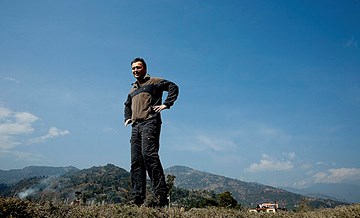Norway assisting climate research in Himalayas
Historical archive
Published under: Stoltenberg's 2nd Government
Publisher: Office of the Prime Minister
News story | Date: 08/02/2008
“In no other part of the world are so many people so dependant on river water from snow and glaciers as in the Himalayas. There is a strong need for more knowledge of the consequences of increased temperatures in the Himalayan region”, Norwegian Prime Minister Jens Stoltenberg says.
“In no other part of the world are so many people so dependant on river water from snow and glaciers as in the Himalayas. There is a strong need for more knowledge of the consequences of increased temperatures in the Himalayan region”, Norwegian Prime Minister Jens Stoltenberg says.
The effect of climate change for the countries in the Himalayan region is a central topic during Mr. Stoltenberg’s visit to Nepal.
The Himalayas are often described as the world’s ”third pole”. Glaciers are vital resources for freshwater and hydroelectric power, for fisheries, agriculture and transportation. Increasing temperatures have already caused Himalayan glaciers to start diminishing.
Climate models estimate a further global temperature increase of two to four centigrade by the end of the century. In the worst case this could cause an 81 per cent reduction in Himalayan ices, major changes in water supply and increased danger of floods and droughts. This may affect as many as 1.3 billion people, mainly in India, Bangladesh, China and Pakistan.

Prime Minister Jens Stoltenberg in Katmandu, Nepal. Photo: Scanpix
Common challenges for the ”three poles”
”The melting of snow and ice due to climate change is a common challenge for the ”three poles” of the Arctic region, the Antarctic region and the Himalayas. Cooperation between scientists studying the three poles may contribute to expand this knowledge. This will again give national authorities a better basis for introducing measures to reduce the effects of climate change”, Mr. Stoltenberg says.
Norway has agreed to provide NOK 25 million in financial support to the International Centre for Integrated Mountain Development (ICIMOD) in Nepal. The Centre is facilitating the exchange of knowledge and information between Himalayan countries, in order to improve nature conservation and to adapt to climate change.
Norway has been supporting the ICIMOD for a number of years, and has this year increased its support by NOK 5 million, to ICIMOD’s work on climate change in the Himalayan region.
Norwegian scientists have already been studying environmental effects in the Arctic region. Norway will offer financial support for Norwegian research centres CICERO and UNEP/GRID-Arendal to convey their competence and experience to ICIMOD and their partners in the Himalayan region.
Norwegian assistance to Nepal
After the Democratic Movement came to power in Nepal in April 2006 Norway’s assistance to the country has seen a considerable increase, from NOK 160 million in 2006 to around NOK 245 million in 2007. A particular increase has taken place in the support for peace and democracy efforts and for the development of clean energy.
”No foreign participant has had a direct role in Nepal’s peace process. Still, Norway has offered financial support for the Nepalese Government and the UN during the peace process. Nepal also receives support for education and rural development projects. Assistance reaching local people is an important contribution to secure popular support for the peace process”, Prime Minister Stoltenberg says.
Norway has been supporting the development of hydroelectric power production in Nepal. One of the largest private hydroelectric power plants in the country has Norwegian SN Power as its majority owner. The plant represents more than ten per cent of Nepal’s total power production.